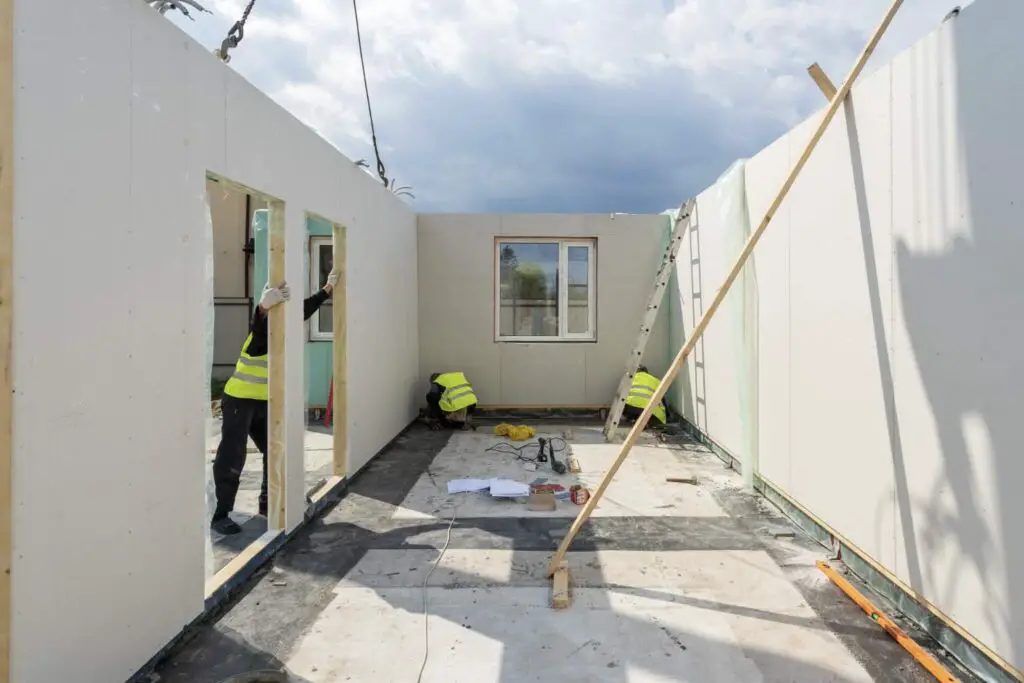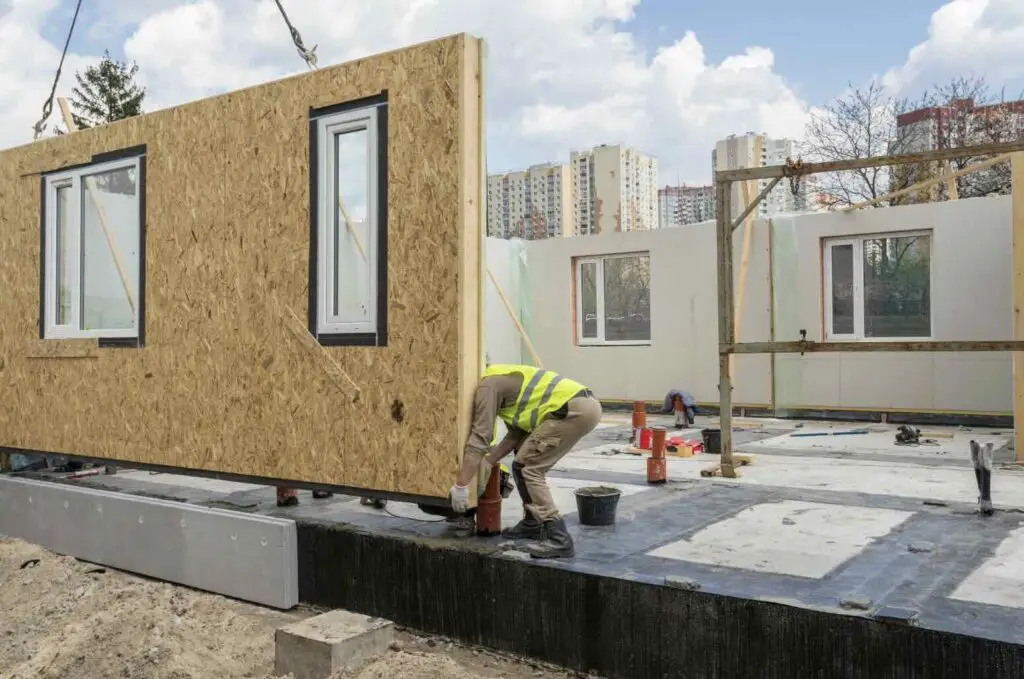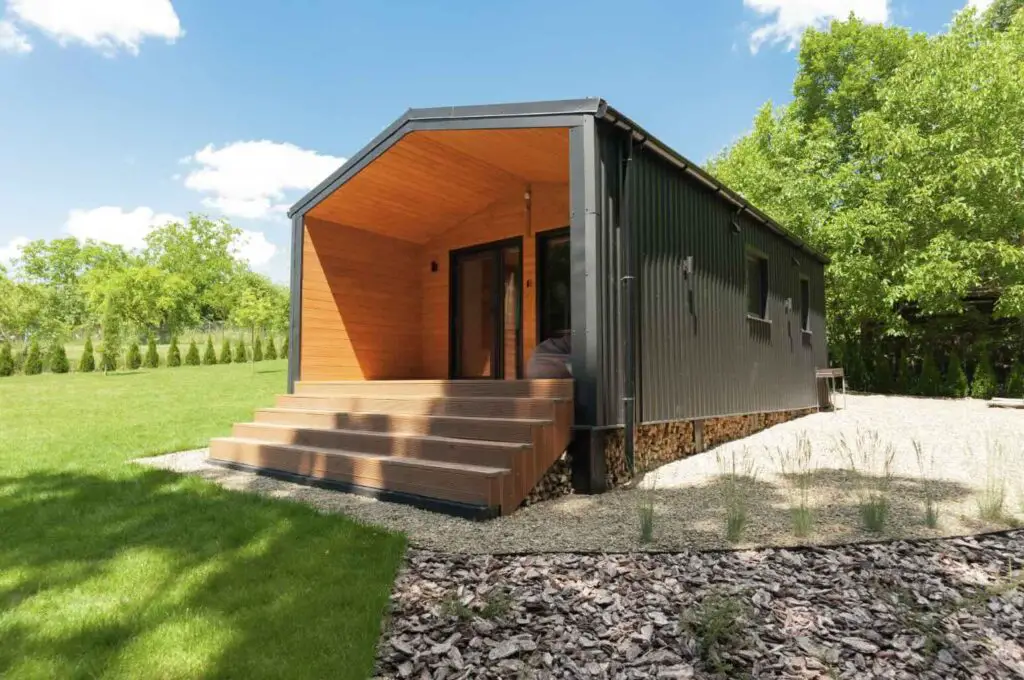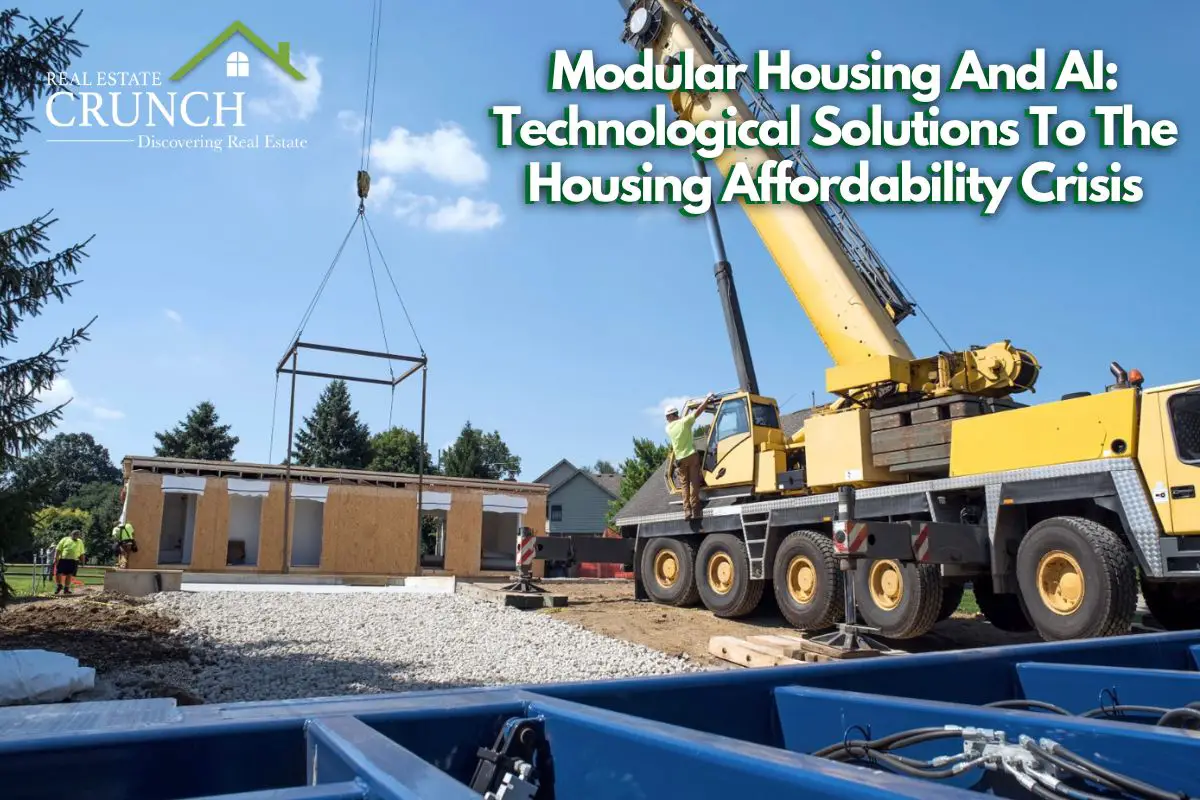It’s impossible to skim through today’s headlines without encountering discussions about the housing crisis. From skyrocketing prices to a severe shortage of units, the dream of affordable housing seems more elusive than ever. For decades, America has not built enough homes to keep up with demand, leading to a market where prices are steeply climbing.
At Real Estate Crunch, we are staunch advocates for innovative solutions to these pressing issues. We believe that modular housing, combined with the latest advancements in artificial intelligence (AI) and other technologies, is critical to easing the housing affordability crisis. This article delves into how these technologies are not just futuristic concepts but practical solutions capable of transforming the housing landscape.
Table of Contents
- The Promise Of Modular Housing Explored
- Leveraging AI And Technology: Modular Home Manufacturing
- Why It Matters – AI, Technology, And Modular Home Manufacturing
- Case Study: The Success Of Sweden’s Modular Home Industry
- Related Questions
The Promise Of Modular Housing Explored
Having spent many years in the manufacturing industry, mainly focused on interior home products, I have gained a comprehensive understanding of the manufacturing processes, which can be highly beneficial in modular housing construction. While my expertise is more aligned with interiors, the principles of efficient manufacturing are universally applicable, particularly in the context of building homes.
Traditionally, homes are built on-site from the outside. Still, modular housing flips this process to an inside-out approach, where much of the construction is completed in a factory setting. This method is not just innovative but also significantly more efficient.
Building in a controlled environment reduces material waste, minimizes weather-related delays, and streamlines the construction process through advanced manufacturing techniques. I firmly believe that this factory-based approach to constructing homes is the future, especially for meeting the rising demand for affordable and quality housing quickly and efficiently.

Modular Homes And The Streamlined Construction Process:
Modular homes are constructed in controlled factory settings, using pre-made sections or modules transported and assembled on-site. This method drastically reduces construction times, reduces waste, and requires fewer labor hours than traditional construction methods, promising a quicker turnaround at lower costs.
Scalability And Efficiency:
The scalability of modular construction means it can quickly respond to high demand in housing, providing more homes faster than conventional building methods. Efficiency gains from factory settings also extend to better quality control and less variability in the building process.
Leveraging AI And Technology: Modular Home Manufacturing
We are firmly committed to harnessing both AI and various technological innovations in the modular manufacturing of homes and other construction units. By integrating advanced technologies into our processes, we aim to enhance efficiency, improve precision, and optimize overall production in the construction industry.
This commitment helps refine the quality and sustainability of our construction projects and ensures that we stay at the forefront of the housing solution market.
Ways To Leverage Technology And AI In Module Home Manufacturing
There are many ways that AI and technology have been used to help leverage the manufacturing of modular homes; below are some ways to leverage technology and AI in Modular Home construction:
Intelligent Design And Planning:
AI can profoundly impact housing design and construction planning. By harnessing data and predictive analytics, AI algorithms can optimize building designs, improve material utilization, enhance energy efficiency, and predict future maintenance needs, ensuring sustainable living solutions.
Automation In Construction:
AI-driven robots and automated machinery can perform complex tasks from framing to installing drywall, which speeds up the building process and reduces human error. Automation extends to logistical aspects of housing construction, like inventory management and supply chain coordination, improving time and cost efficiencies.
Customization At Scale:
Through AI, modular housing can achieve a high degree of customization. Potential homeowners can select layouts, materials, and features in real time, using software that instantly adapts plans to meet their demands without significantly impacting production speed or cost.
AI and Construction: Optimizing Modular Components For Efficiency
In the rapidly evolving construction industry, Artificial Intelligence (AI) is set to play a pivotal role, particularly in modular construction. AI’s capabilities are being harnessed to revolutionize how buildings and their components are designed, manufactured, and assembled.
Here’s how AI is making strides in optimizing modular construction for better outcomes:
Enhanced Structural Integrity
AI algorithms are increasingly used to analyze and enhance the structural integrity of building components. By processing complex data and simulations, AI can predict the design’s stress points and potential vulnerabilities before production begins.
This preemptive analysis helps construct safer and more durable buildings over their lifespan.
Material Efficiency
One of AI’s significant impacts lies in its ability to optimize material usage, ensuring that each component is as efficient and effective as possible. AI systems evaluate various materials for their strength, durability, and environmental impact, recommending combinations that improve the overall quality of the modular units while reducing waste.
This is particularly crucial in a world striving for sustainability, ensuring resources are utilized best without compromising quality.
Cost-Effectiveness
AI’s predictive analytics can streamline production by forecasting optimal component assembly methods and identifying the most cost-effective material inputs.
This capability allows companies to save on production costs without sacrificing safety or quality. Modular construction becomes more viable and attractive to a broader market by minimizing unnecessary expenses.

Manufacturing Precision
AI dramatically aids in achieving higher precision during the manufacturing process. It controls machinery to perform exact cuts and alignments, drastically reducing the margin of error compared to human-operated equipment.
This precision is crucial in modular construction, where components need to fit perfectly during assembly to maintain the integrity of the constructed building.
Lighter, Stronger Building Components
Through extensive data analysis, AI can help design parts and components that are lighter and stronger than traditional methods. Lighter components reduce logistical costs and facilitate easier assembly, while their enhanced strength ensures the longevity and durability of buildings.
AI’s integration into modular construction transforms the industry by making processes more intelligent—from planning and design to production and assembly. As companies continue to adopt this technology, we can expect the construction of modular components to become more efficient, cost-effective, and sustainable.
This advancement is not just a leap towards better construction techniques but also a step forward in making modern construction align with the demands of the future, ensuring that buildings are built faster, with higher quality, and at a lower cost.
Why It Matters – AI, Technology, And Modular Home Manufacturing
You might wonder why any of this matters. After all, homes have been built on-site for centuries, and the process has served us well. So why shift to factory-based construction now?
The reasons for this transition are numerous and compelling, highlighting the significant benefits that modular manufacturing can bring to the construction industry. Here are some reasons:
Addressing The Affordability Crisis
Modular homes and AI can make housing more affordable and accessible by reducing building costs and time. These savings can be passed on to consumers, offering lower price points and helping to ease the burden of housing affordability.
Sustainable Practices
Modular homes are often more sustainable than traditional builds, using materials more efficiently and reducing on-site construction waste. Combined with AI’s ability to optimize energy use, these homes lower costs and minimize environmental impact.
Meeting Rising Demand
With urbanization and populations growing, the demand for quick, efficient housing solutions will only increase. Modular housing and AI offer viable solutions to meet these needs swiftly without sacrificing quality or affordability.

Case Study: The Success Of Sweden’s Modular Home Industry
Sweden’s modular home industry provides a remarkable example of efficiency and innovation in construction. Visiting facilities like Lindbäcks, a leading modular home construction company, reveals a stunningly clean and orderly environment—so immaculate that you might eat off the floor.
This cleanliness is a testament to the sophisticated processes that eliminate common construction byproducts like sawdust and dust.
Sweden’s Approach To Modular Construction
For years, Sweden has been refining its approach to building modular homes. The key to their success lies in integrating advanced technology and the strategic retraining of construction workers to adapt to this high-tech environment.
This industry-wide upskilling enables workers to proficiently handle data and operate complex machinery, making the construction process smoother and more efficient.
Technological Advancements:
Swedish companies like Lindbäcks are at the forefront of the modular construction industry, employing cutting-edge technology to enhance productivity and effectiveness. These advancements include:
- Automation: Much of the physical construction work in Swedish modular factories is automated. This automation extends from basic tasks such as framing and nailing to more complex processes like electrical fittings and plumbing; all carried out with precision by robots.
- Data Integration: Sweden’s modular home industry utilizes sophisticated data analytics to optimize material usage and workflow efficiency. This data-driven approach minimizes waste and ensures that all construction aspects align with demand forecasts and customer specifications.
- Cross-Industry Learning: The industry has borrowed lean manufacturing techniques from the automobile industry, which companies like Volvo have famously innovated. These practices help streamline operations and maintain high productivity levels without compromising quality.
Quality And Compliance:
One of the most impressive aspects of Sweden’s modular home industry is its commitment to quality. Despite the high-speed manufacturing and assembly, the final products meet and often exceed stringent building codes. This high standard is maintained through rigorous testing and quality control processes, integral to the factory setting.
Efficiency And Cost-Effectiveness:
The structured environment of modular home factories significantly cuts down construction time. It also allows for better budget control and reduces the overall construction cost, making homes more affordable to consumers. Additionally, the controlled setting reduces the risk of delays related to weather, which is a common issue in traditional on-site construction.
Sustainability:
Swedish modular homes are designed with sustainability in mind. The use of pre-cut materials and precise construction methods substantially reduces waste. Furthermore, these homes are often equipped with energy-efficient systems that lower the buildings’ carbon footprint.
Sweden’s modular home industry stands as a leading example for the United States and other countries, showcasing how to efficiently and effectively leverage technology in construction.
The methodologies adopted by Swedish companies highlight the potential benefits of modular construction—not just in terms of efficiency and cost-effectiveness but also in terms of sustainability and quality. This industry’s ongoing success is a powerful model for others to follow, proving that proper practices can address the housing crisis effectively and innovatively.
Integrating modular housing with AI and technology presents a compelling solution to the housing affordability crisis.
You Can Listen To Our Podcast About Can Modular Housing and AI Solve the Housing Affordability Crisis?
Below or By clicking here.

At Real Estate Crunch, we are excited about the possibilities these innovations bring for streamlining construction processes and making sustainable and affordable housing a reality for more people. As these technologies evolve and scale, their role in solving housing challenges will undoubtedly expand, reshaping the future of real estate development and addressing the needs of millions seeking a place to call home.
Real Estate Crunch gives you real property and real estate information and advice. We offer a free monthly newsletter; you can sign up for our newsletter by clicking here.
We also have a weekly podcast called “Real Estate Crunch,” found on all major podcast platforms. Listen to our podcast by clicking here.
Follow us on our social media platforms – Facebook and Instagram.
Related Questions
Professional Ways To Ask Tenants To Vacate A Property
When you own a property and are renting it out, there may be a time when you want your tenant to vacate the property legally. This situation can be tricky as the tenant legally has the right to use the property during their lease period.
By clicking here, you can read more about Professional Ways To Ask Tenants To Vacate A Property.
What Can I Do About A Rude Property Manager?
If the property manager is rude and you can rent from someone else, we suggest you try to find someone else to rent from; but if that is not possible, then there are steps you can take to ensure you are protected and try to defuse the situation.
By clicking here, you can read more about What Can I Do About A Rude Property Manager?
3 Ways To Keep Track Of Your Tenants Rent
If you are a landlord, there are some basic methods that you can use to keep track of your tenant’s rental payments. Most people will use the three primary ways: a manual, a computer excel sheet, and rental management software. Today there are a lot of excellent computer software programs to help landlords manage their property.
By clicking here, you can read more about 3 Ways To Keep Track Of Your Tenants Rent.


